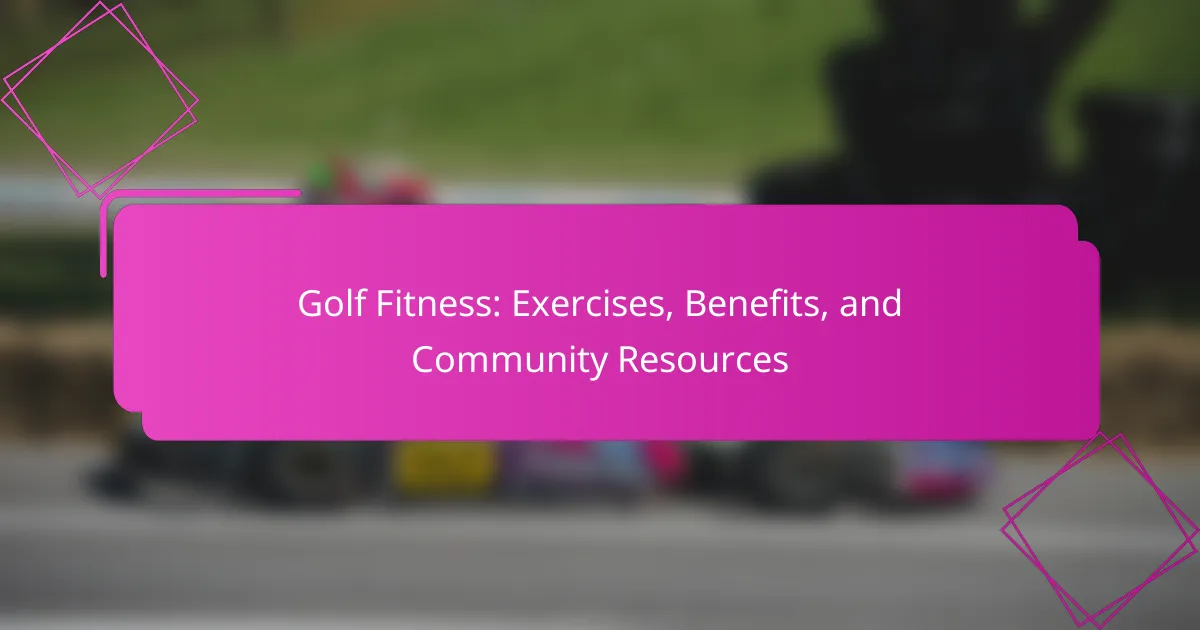Improving golf fitness can enhance performance and reduce injury risk. This article covers key exercises like squats and yoga, highlights the benefits of increased strength and flexibility, and explores community resources such as local fitness classes and golf-specific training programs. Understanding regional differences and avoiding common mistakes will further support your fitness journey.

What exercises improve golf fitness and performance?
Strength training, flexibility exercises, and cardiovascular workouts enhance golf fitness and performance. Key exercises include squats, lunges, rotational medicine ball throws, and yoga. These improve strength, balance, and flexibility, crucial for a powerful swing. Engaging in a consistent routine can lead to better on-course results. Community resources like local fitness classes and golf-specific training programs can support your fitness journey.
How do strength training exercises benefit golfers?
Strength training exercises enhance golfers’ performance by improving strength, flexibility, and stability. These benefits lead to increased swing power, better control, and reduced injury risk. Enhanced core strength from exercises like squats and deadlifts supports a more powerful and consistent swing. Additionally, strength training promotes better posture, which is crucial for an effective golf stance. As a result, golfers can achieve greater distance and accuracy in their shots.
Which flexibility routines enhance swing mechanics?
Dynamic stretching routines enhance swing mechanics in golf. Incorporating exercises like leg swings, torso twists, and hip openers improves flexibility, stability, and range of motion. These routines prepare the body for the rotational demands of a golf swing, promoting better performance and reducing injury risk. For example, a study found that golfers who engaged in flexibility training showed a 15% increase in swing speed. Regular practice of these routines can lead to significant improvements in overall golf fitness and technique.
What role does cardiovascular fitness play in golf?
Cardiovascular fitness significantly enhances golf performance by improving endurance, stability, and swing power. Better cardiovascular health leads to increased stamina, allowing golfers to maintain energy levels throughout a round. Additionally, it supports recovery between swings and reduces fatigue-related errors. Enhanced cardiovascular fitness can also improve mental focus, which is crucial for strategic decision-making on the course.
How can golfers incorporate balance training into their workouts?
Golfers can incorporate balance training into their workouts by integrating specific exercises designed to enhance stability and coordination. Incorporating activities such as single-leg stands, stability ball exercises, and balance board drills can significantly improve swing consistency. These exercises target core muscles, which are crucial for maintaining posture during swings. As a result, golfers can enhance their performance and reduce the risk of injuries. Regular practice of balance training can lead to noticeable improvements in overall golf fitness and skill.
What are the best warm-up and cool-down exercises for golfers?
The best warm-up and cool-down exercises for golfers include dynamic stretches and static stretching. Warm-up exercises like arm circles, leg swings, and torso twists prepare the body for movement. Cool-down exercises such as hamstring stretches, quadriceps stretches, and shoulder stretches help improve flexibility and aid recovery. These exercises enhance performance and reduce injury risk.

What are the key benefits of golf fitness?
Golf fitness enhances performance, reduces injury risk, and improves overall health. Key benefits include increased strength, flexibility, and endurance, which contribute to better swing mechanics and power. Improved core stability aids in maintaining balance during play. Additionally, engaging in golf fitness fosters a sense of community and encourages a healthier lifestyle. Regular training can lead to enhanced mental focus, benefiting both the game and personal well-being.
How does improved fitness impact golfing performance?
Improved fitness significantly enhances golfing performance by increasing strength, flexibility, and endurance. These factors contribute to better swing mechanics and overall stamina during play. Enhanced core strength leads to more powerful drives, while increased flexibility allows for a greater range of motion, improving accuracy. Additionally, better cardiovascular fitness helps maintain energy levels throughout a round, reducing fatigue. Engaging in golf-specific exercises can lead to measurable improvements in performance metrics, such as swing speed and distance.
Why is injury prevention crucial for golfers?
Injury prevention is crucial for golfers to enhance performance and ensure longevity in the sport. Effective injury prevention strategies reduce the risk of common golf-related injuries such as lower back pain and tendonitis. Incorporating fitness exercises tailored for golfers improves strength, flexibility, and balance, which are essential for a powerful and safe swing. Furthermore, a supportive community provides resources and guidance, fostering a culture of health and safety among golfers. Prioritizing injury prevention not only enhances enjoyment but also extends a golfer’s playing career.
What mental benefits can golfers gain from fitness routines?
Golfers can gain significant mental benefits from fitness routines, including improved focus, reduced stress, and enhanced confidence. Regular exercise boosts endorphins, which can elevate mood and increase mental resilience. Additionally, fitness routines can enhance cognitive function, aiding in strategic decision-making on the course. Engaging in physical activity also fosters a sense of community among golfers, contributing to social well-being. Overall, integrating fitness into a golf routine can lead to a more positive mental state, directly impacting performance.

Which community resources support golf fitness initiatives?
Community resources that support golf fitness initiatives include local golf clubs, fitness centers, and online platforms. These resources provide specialized training programs, workshops, and access to professional trainers. Many golf associations also offer fitness guidelines tailored for golfers, emphasizing strength, flexibility, and endurance. Additionally, community events often promote golf fitness through group activities and educational seminars, fostering a supportive environment for enthusiasts.
What local fitness programs cater specifically to golfers?
Local fitness programs specifically catering to golfers include specialized training sessions, golf-centric yoga classes, and strength conditioning workshops. Many golf clubs and community centers offer these programs to enhance performance and prevent injuries.
For example, the “Golf Fitness Program” at XYZ Golf Club focuses on flexibility and strength tailored for golfers. Additionally, local fitness studios may provide classes that emphasize core stability and swing mechanics. Engaging in these programs can significantly improve a golfer’s game while fostering a sense of community among participants.
How can golfers benefit from joining fitness-focused golf clubs?
Joining fitness-focused golf clubs offers golfers enhanced physical conditioning, improved performance, and a supportive community. These clubs provide specialized exercises targeting strength, flexibility, and endurance, which are essential for optimal swing mechanics. As a result, golfers experience reduced injury risk and increased longevity in the sport. Additionally, being part of a fitness-oriented community fosters motivation and accountability, encouraging consistent practice and healthy habits. This holistic approach not only enhances golfing skills but also promotes overall well-being, making it a valuable investment for any golfer.
What online platforms offer golf fitness coaching and resources?
Several online platforms offer golf fitness coaching and resources, including Golf Fitness Online, MyGolfFitness, and the Titleist Performance Institute. These platforms provide tailored exercises, instructional videos, and community support to enhance golfers’ physical performance. Access to professional trainers and fitness assessments is also available, ensuring a comprehensive approach to golf fitness.

How do regional differences influence golf fitness practices?
Regional differences significantly shape golf fitness practices through variations in climate, culture, and available resources. For instance, warmer regions may emphasize outdoor training, while colder areas focus on indoor facilities. Cultural attitudes towards fitness also influence exercise routines and community engagement. Access to local resources, such as trainers and equipment, further tailors fitness approaches to regional needs.
What unique golf fitness trends are emerging in various regions?
Emerging golf fitness trends vary by region, focusing on functional training, mobility exercises, and technology integration. In North America, high-intensity interval training is popular for improving endurance. Europe emphasizes yoga and flexibility for injury prevention. Asia is integrating virtual reality for immersive training experiences. These trends reflect local preferences and cultural influences in golf fitness practices.
How do cultural attitudes towards fitness impact golfers’ routines?
Cultural attitudes towards fitness significantly influence golfers’ routines by shaping their commitment and approach to training. In cultures that prioritize physical fitness, golfers are more likely to incorporate structured exercise regimens, enhancing their performance and longevity in the sport. Conversely, in cultures where fitness is less emphasized, golfers may neglect physical conditioning, potentially hindering their skills and overall health. This disparity highlights the importance of community resources and support systems that promote fitness within the golfing community. As a result, golfers who engage with fitness-oriented cultures often experience improved physical benefits, such as increased strength and flexibility, which directly contribute to their game.

What common mistakes should golfers avoid in their fitness journey?
Golfers should avoid common mistakes such as neglecting flexibility training, focusing solely on strength, skipping warm-ups, and ignoring recovery. These missteps can hinder performance and increase injury risk.
1. Neglecting flexibility training: This limits range of motion, affecting swing mechanics.
2. Focusing solely on strength: Balance strength with endurance and flexibility for optimal performance.
3. Skipping warm-ups: Proper warm-ups prepare muscles for activity, reducing injury risk.
4. Ignoring recovery: Recovery is crucial for muscle repair and overall fitness progress.
How can golfers ensure they are training safely and effectively?
Golfers can ensure safe and effective training by following structured guidelines. Prioritize proper warm-up and cool-down routines to prevent injuries. Incorporate strength and flexibility exercises targeting core, legs, and upper body to enhance performance. Utilize professional resources, such as trainers or golf fitness programs, to tailor workouts to individual needs. Regularly assess progress and adjust training regimens accordingly to maintain effectiveness and safety.
What are the pitfalls of neglecting recovery in golf fitness?
Neglecting recovery in golf fitness can lead to injuries, decreased performance, and burnout. Recovery is essential for muscle repair, flexibility, and mental focus. Without it, golfers may experience fatigue, reduced strength, and longer recovery times. Prioritizing recovery strategies, such as rest days and active recovery, enhances overall performance and longevity in the sport.
How can golfers maintain motivation in their fitness routines?
Golfers can maintain motivation in their fitness routines by setting specific goals and tracking progress. Establishing a consistent schedule enhances accountability. Joining a community or fitness group provides support and encouragement. Incorporating variety in exercises prevents boredom and promotes engagement. Celebrating small achievements boosts morale and reinforces commitment.
What best practices can enhance a golfer’s fitness regimen?
Incorporating specific exercises can significantly enhance a golfer’s fitness regimen. Focus on strength training, flexibility exercises, and cardiovascular workouts to improve performance and reduce injury risk.
Strength training builds core stability, essential for powerful swings. Flexibility exercises enhance range of motion, aiding in swing mechanics. Cardiovascular workouts boost endurance, allowing golfers to maintain energy throughout a round.
Utilize community resources like local gyms or golf fitness programs for structured guidance. Engaging with fellow golfers can provide motivation and accountability, fostering a supportive environment for fitness improvement.
